Key takeaways:
- Work-life balance involves setting clear boundaries and intentional scheduling to maintain harmony between professional and personal passions.
- Effective event planning fosters community connections and storytelling, enhancing audience engagement and supporting emerging artists.
- Time management strategies, like creating a master calendar and reflecting on performance, are crucial for balancing multiple responsibilities.
- Successful event execution relies on meticulous planning, open communication, and embracing the experience during the event itself.
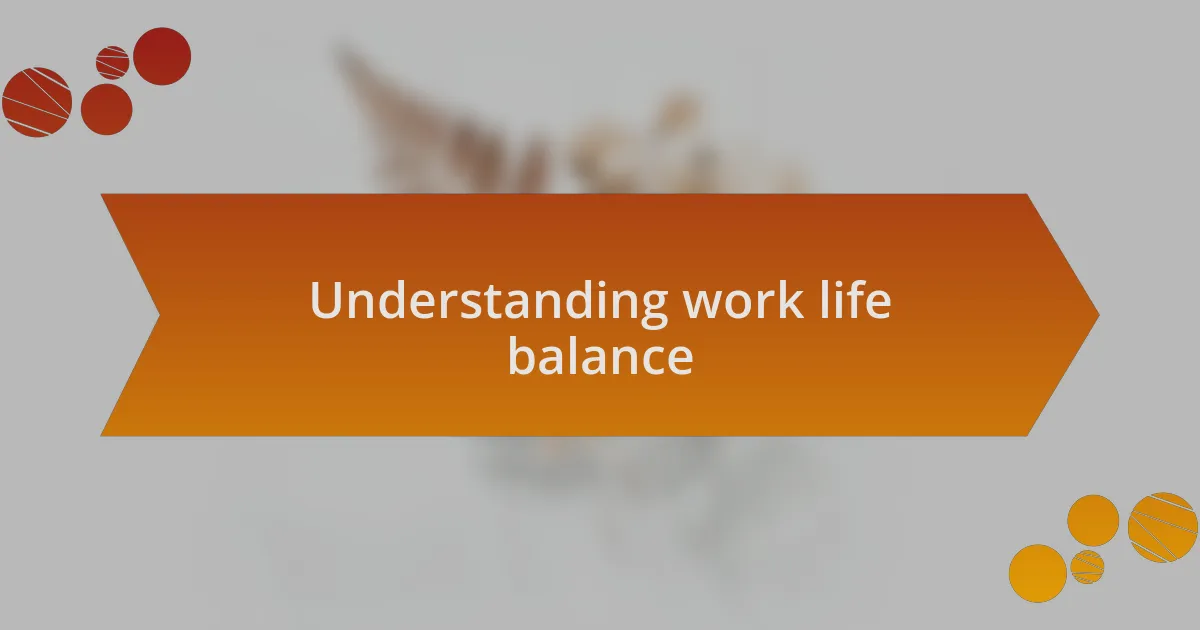
Understanding work life balance
Understanding work-life balance is essential, especially when juggling demanding careers and passion projects like event planning. I remember a time early in my career when I felt overwhelmed, constantly torn between my day job and organizing a large art exhibition. It was in this chaos that I learned that taking small breaks was crucial, not just for my well-being, but also for fostering creativity.
What does work-life balance actually mean? For me, it’s not just about splitting hours between work and personal life; it’s about harmony. I found that setting clear boundaries transformed my approach. It was during a particularly hectic week that I decided to turn off my work notifications during dinner with my family. This single choice not only improved my relationships but also re-energized my creativity when I returned to work.
I often ask myself: How can I prioritize my passion without sacrificing my professional responsibilities? The answer lies in intentional scheduling. I began viewing my calendar as a canvas where every task found its place. It became a powerful tool to create a balanced life, where event planning and work coexisted cohesively, rather than as competing priorities.

The role of event planning
The role of event planning extends far beyond logistics; it’s a creative outlet that allows me to bring together art and community. I vividly recall coordinating a gallery opening where I had the chance to collaborate with local artists and caterers. That experience was both exhilarating and fulfilling, reminding me of the profound impact meaningful events can have on fostering connections.
In my opinion, effective event planning serves as a bridge between the gallery and its audience. Each detail, from the theme to the layout, was purposefully crafted to enhance the viewer’s experience. I often ponder: How can we ensure each event resonates? For me, it’s about storytelling; every exhibit is a narrative waiting to unfold, making careful planning vital.
As I reflect on my journey, I realize that event planning has taught me invaluable lessons about time management and resource allocation. Balancing work demands with the excitement of orchestrating an event requires a strategic mindset. I’ve picked up techniques for prioritization that help me stay focused, like setting mini-deadlines for creative projects, which keeps me motivated while ensuring no aspect of the planning process gets overlooked.
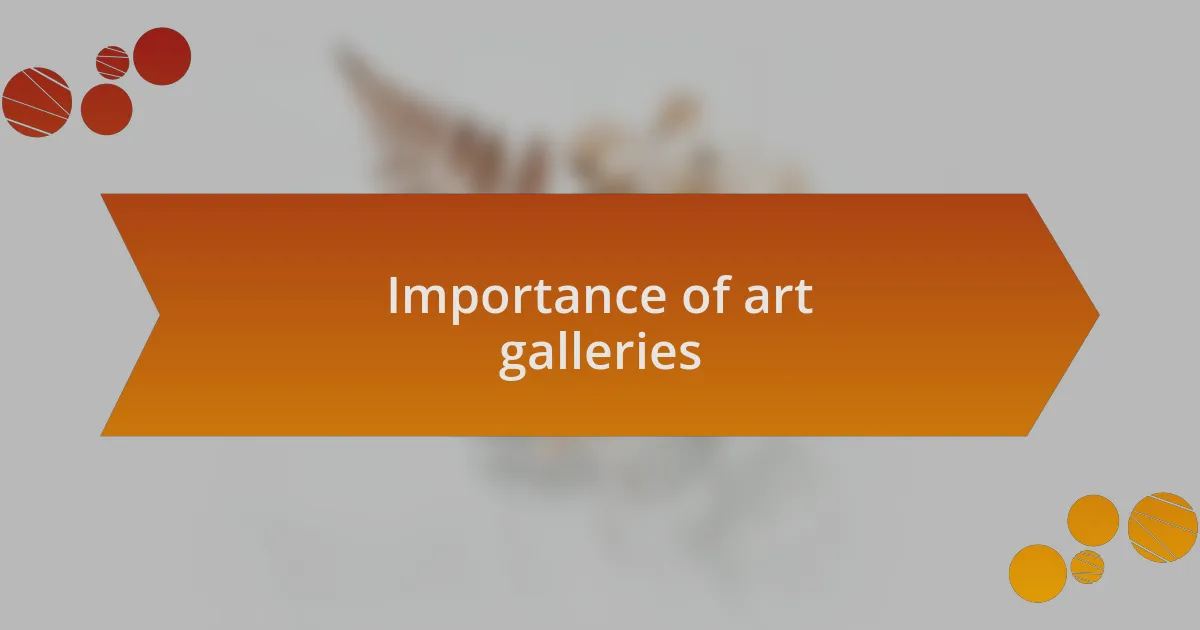
Importance of art galleries
One of the most significant aspects of art galleries is their ability to cultivate a sense of community. I remember attending a local gallery exhibit that featured artists from diverse backgrounds. It was heartwarming to witness people connecting over a shared love for art, igniting conversations that transcended cultural barriers. How often do we find spaces that genuinely foster such connections? Galleries provide that unique environment where interaction thrives.
Art galleries also serve as vital platforms for emerging artists to showcase their work. I distinctly recall meeting a young painter at an exhibition who shared how the exposure helped him secure commissions. It dawned on me that galleries not only exhibit art but also nurture talent and ambition. They ignite dreams, making a profound difference in an artist’s journey.
Furthermore, they play an educational role, allowing the public to engage with art on a deeper level. I often find myself captivated by the stories behind each piece on the wall. The opportunity to learn about different artistic movements or personal experiences of artists adds layers of meaning to the viewing experience. Isn’t it fascinating how much art reflects societal issues? Galleries spark dialogues and challenge perspectives, making them essential in today’s cultural landscape.

Key challenges in balancing both
One major challenge I faced while balancing work and event planning was time management. There were days when I’d feel overwhelmed by deadlines on one front while planning an exhibition on the other. I often found myself wondering, “How do I prioritize without sacrificing quality?” The key was learning to set boundaries and allocate specific time blocks for each responsibility, but that took time and practice to perfect.
Another obstacle was the emotional toll of juggling high-stakes events with daily work pressures. I remember a particularly stressful week leading up to an art opening, where every little hiccup felt magnified. Questions like, “What if the artist isn’t satisfied?” or “What if the turnout is low?” haunted me during those nights. Finding ways to manage the stress, whether through meditation or delegating tasks, became essential in preserving my mental energy.
Lastly, coordinating with different stakeholders involved in event planning often led to conflicting priorities. I recall a situation where a vendor’s last-minute changes clashed with my work commitments. It made me wonder, “How can I keep everyone aligned?” I soon realized that clear communication and setting expectations upfront could ease tension and ensure smoother collaboration while maintaining my work obligations.
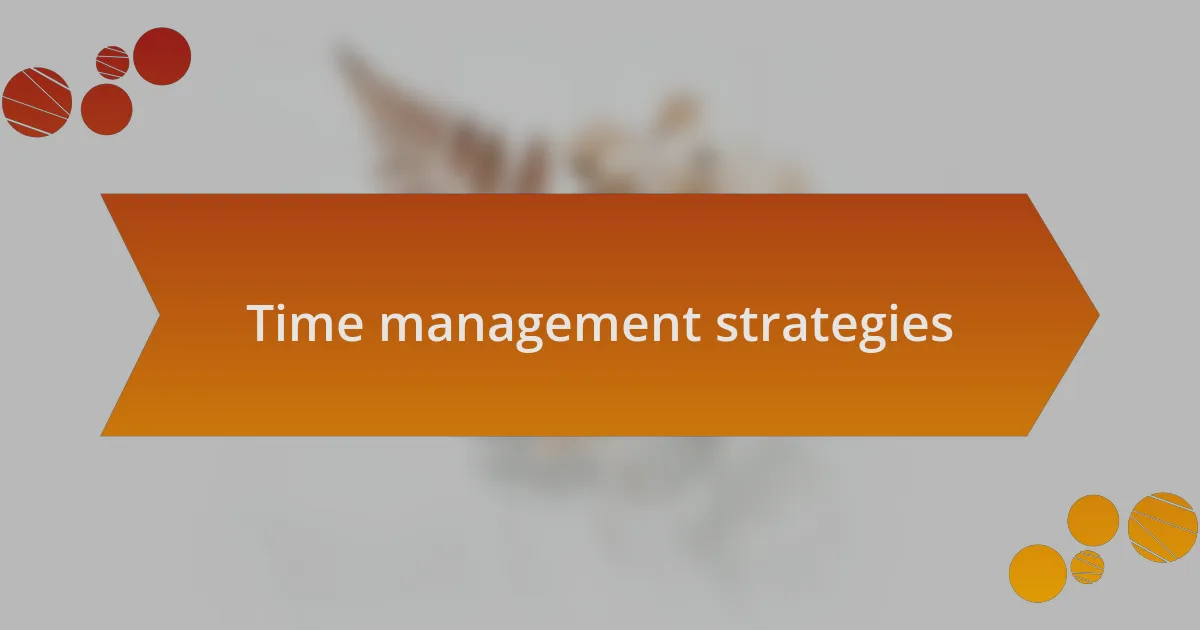
Time management strategies
When it comes to effective time management, I found that creating a master calendar was a game changer for me. I learned to block out time for both work and event planning, allowing me to visualize my week at a glance. Did I ever miss deadlines? Absolutely. But having that visual structure helped me identify potential conflicts before they became stressful surprises.
One time, I experimented with the Pomodoro Technique, where I worked in focused bursts of 25 minutes followed by a short break. I was skeptical at first, but I discovered that those little intervals actually helped maintain my concentration. Have you ever noticed how a ticking clock can make tasks seem more urgent? That urgency drove me to prioritize effectively, minimizing procrastination and boosting my productivity.
Moreover, I realized the importance of reflection at the end of each week. I took a moment to assess what went well and what could improve. There were moments I felt like I was on a roller coaster, with high peaks of success and sudden drops of chaos. These reflections not only encouraged me to fine-tune my time management strategies but also helped me celebrate small wins that kept my motivation alive amidst the hustle. What’s your reflection process like?
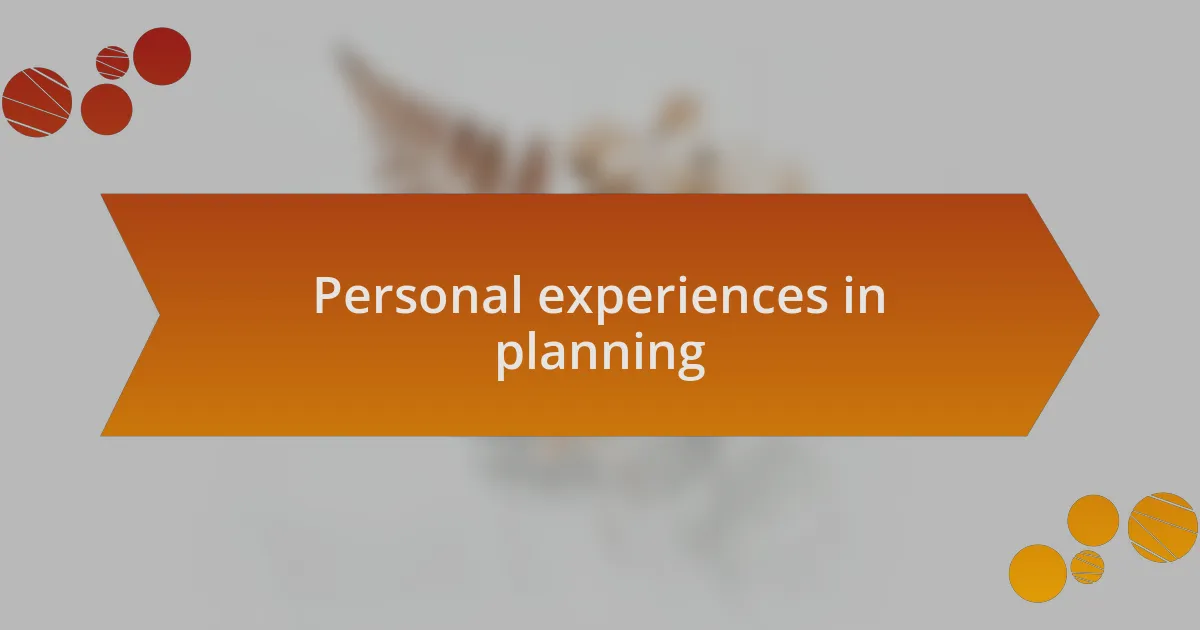
Personal experiences in planning
Personal experiences in planning
Planning an event can often feel like juggling multiple balls at once. I remember when I was tasked with organizing an art exhibition while balancing my full-time job. There were days I felt overwhelmed, darting between meetings and planning sessions, yet the thrill of bringing artists’ works to life kept me going. Have you ever found motivation in a chaotic situation? For me, it was like breathing life into a blank canvas, even when the palette seemed too limited.
One memorable experience was coordinating the logistics for an opening night. I stress-checked vendors and timelines, feeling the weight of responsibility. Just hours before the event, our catering service fell through. In that moment, panic set in, and I questioned whether I’d mismanaged my time. Yet, thinking back, I quickly reached out to a local restaurant, and they saved the day. It taught me that adaptability is crucial in planning—sometimes, the best outcomes emerge from unexpected challenges. How do you handle last-minute issues?
As I moved through these planning phases, I often found myself caught in a tug-of-war between my professional commitments and my passion for event planning. There were moments when I felt torn and isolated, like I was navigating a labyrinth without a map. However, those feelings prompted me to seek support from colleagues and friends who understood my vision, reminding me that collaboration can ease the burden. Have you ever sought help, only to realize how valuable teamwork can be? The journey of planning has gifted me lessons in resilience, creativity, and the power of connection.
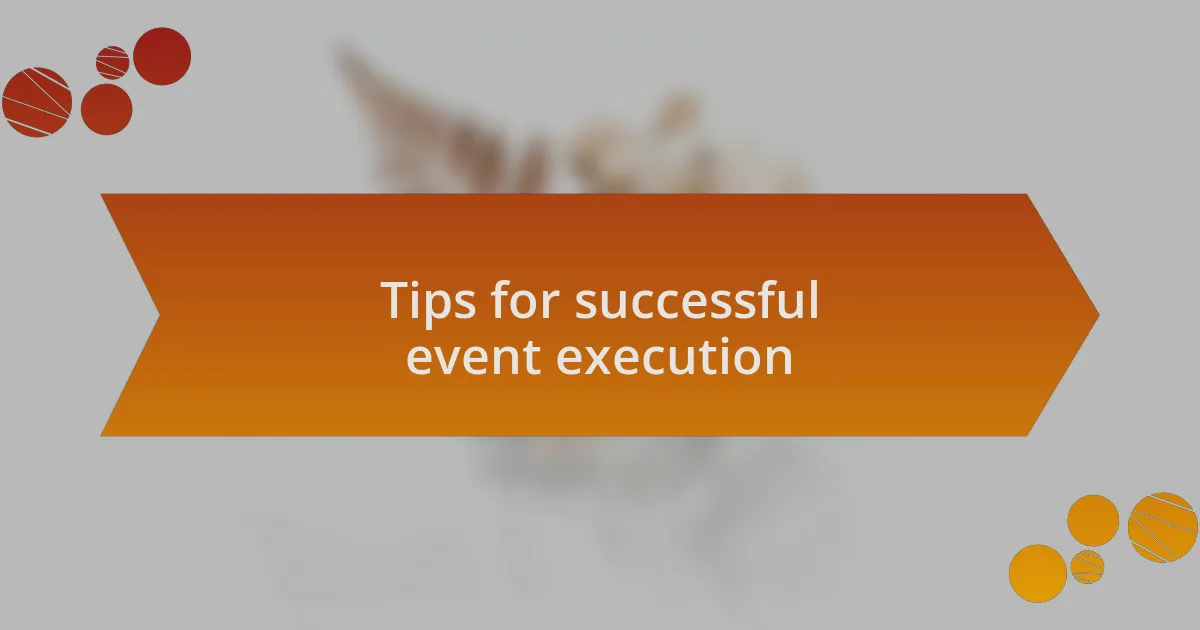
Tips for successful event execution
Successful event execution starts with meticulous planning. I remember sitting down with a color-coded spreadsheet, mapping out every detail from vendor contacts to timelines. It might sound tedious, but that process allowed me to visualize the event as a coherent story, rather than a jumble of responsibilities. Have you ever felt aligned in your planning, where everything just clicks into place?
Another key factor is communication. Before my last gallery event, I made it a point to check in regularly with my team and vendors. This proactive approach not only ensured everyone was on the same page but also strengthened our collaboration. Do you think a simple conversation can uncover potential issues before they arise? I’ve found that a few minutes spent communicating can save hours of troubleshooting later.
Lastly, the day of the event is not just about execution but about embracing the atmosphere you’ve worked so hard to create. I vividly recall stepping into the gallery just as guests started to arrive, feeling a rush of excitement mixed with nerves. It reminded me that every piece of effort contributed to this moment of connection. Have you experienced that electric feeling when your planning pays off? Recognizing that the event itself is a living, breathing experience has helped me approach every execution with joy and engagement.